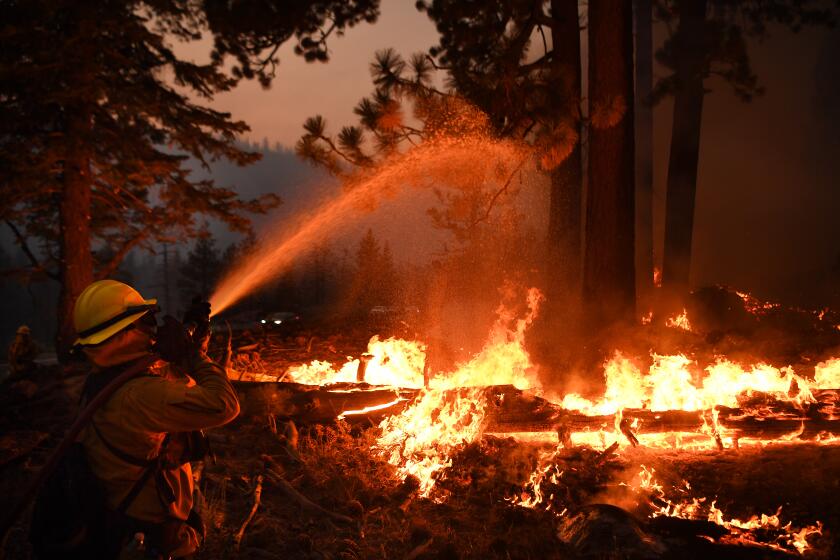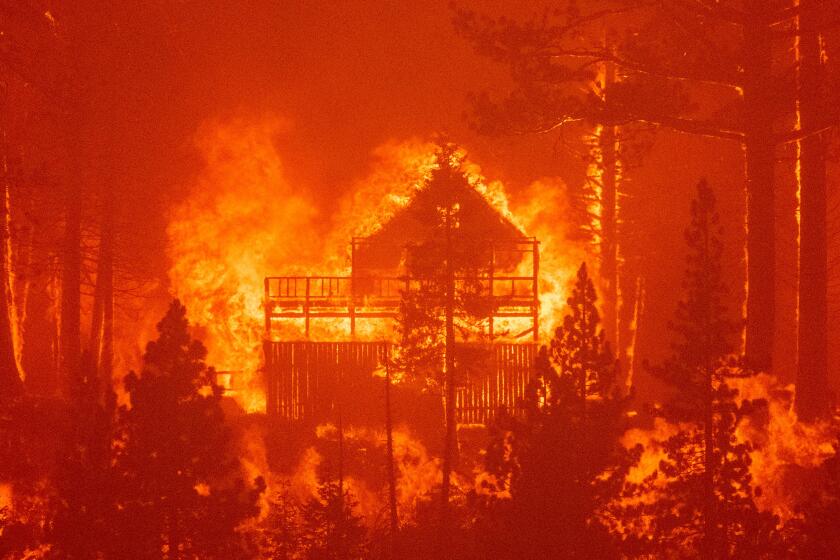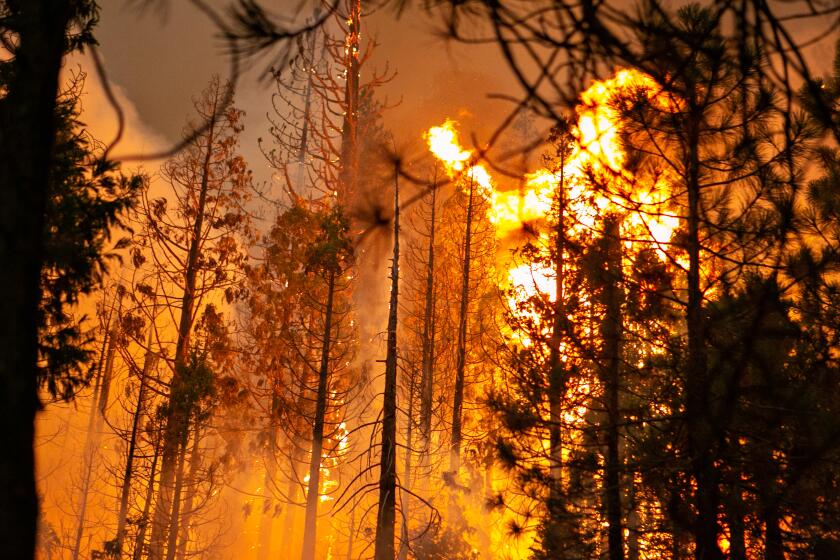Caldor fire pushes toward Nevada, South Lake Tahoe still under threat

- Share via
SOUTH LAKE TAHOE, Calif. — Firefighters made an all-out effort Tuesday to defend South Lake Tahoe and surrounding communities as the Caldor fire raced toward Nevada and forced another slew of evacuations.
Officials said they managed to “herd” the flames away from homes and structures, including many in the Christmas Valley and Meyers, but that the threat is not yet gone: Another day of strong winds and bone-dry conditions is still to come, and crews are bracing for a continuous battle against airborne embers and fast-moving flare-ups.
“Tomorrow is going to be another bad weather day, I’ll be honest with you,” incident meteorologist Jim Dudley said Tuesday evening. “But it will be the last one of those. There is a light at the end of this tunnel.”
Yet little about the Caldor fire has been predictable, with crews on Tuesday describing flames slopping over containment lines, running between treetops and casting embers more than a mile away.
Fire behavior analyst Steven Volmer said given the hot, dry conditions in the fire area, the probability of an errant ember sparking a new fire was “extremely high” — above 90%. And when fires do start, they can spread at speeds of 200 feet per minute between the crowns of trees, and about 100 feet per minute on the ground, he said.
Fueled by heavy winds, the Caldor fire had already jumped Highways 50 and 89 and threatened Echo Summit. Some structures had burned, but it was unclear how many.
By Tuesday night the 199,000-acre blaze was only 18% contained, officials said, and nearly 35,000 structures were threatened. The National Weather Service extended its forecast for intense winds moving to the east and southeast through 11 p.m. Wednesday evening, promising more challenges.
Gov. Gavin Newsom said that of the 15 large active wildfires burning in California, the Caldor fire is among the most worrisome.
“It’s our No. 1 priority to put everything we’ve got on it,” Newsom said, including fire retardant being dropped by aircraft, helicopters making water drops, and the National Guard deployed to battle the blaze.
Thousands rushed to leave South Lake Tahoe as the resort city came under an evacuation order due to the Caldor fire.
Along Highway 50 on Tuesday afternoon, dozens of strike teams from around the state were lined up in their trucks awaiting assignments. Multiple plumes of smoke rose skyward as dozens of spot fires burned in the valley below.
As in the night prior, Tuesday’s mission was to save homes and structures along Pioneer Trail, where the fire was most active, said Dave Lauchner, spokesman for the incident management team and a battalion chief with the Sacramento Fire Department.
Lauchner said that while most structures were saved Monday night, “it was crazy. A lot of fire, turbulent winds.”
Lauchner said he expected more extreme behavior in coming hours as the wind increases.
“We knew this was coming,” he said of the gusts. “The problem is it’s not one direction. It comes from the canyons in all directions.”
The Caldor fire has also changed the view of fire risk in Lake Tahoe.
For many on the fire crews here, the fight is not just professional, it’s personal too. Lauchner’s parents own a cabin just two miles up the road. A few days ago he was reassuring his mother that the fire could never reach this far. Now he’s had to revise that story.
“This fire does stuff I’ve never seen before,” he said.
California Department of Forestry and Fire Protection spokesman Chris Anthony echoed that sentiment during an operations update.
“Historically, we’ve used terms such as ‘anomaly,’ ‘unprecedented’ or ‘extreme’ to describe the wildfires that we have seen burn throughout the state over the past 10 to 20 years,” Anthony said. “These terms are no longer appropriate given the clear trends associated with drought, changing climate and unresilient forest stands.”
“Unfortunately, these factors contribute to the resistance to control that we are seeing with the Caldor fire,” he added.
Cal Fire chief Thom Porter noted that the Caldor fire and the nearby Dixie fire were the first to burn from one side of the Sierra to the other.
A wildfire in South Lake Tahoe would not only threaten lives and homes; it would also move faster, burn hotter and be significantly harder to fight, experts say.
Officials still hope the fire won’t hit the city of South Lake Tahoe. If it does, experts say it could be profoundly destructive.
Not only would an urban conflagration in that area threaten lives and homes, but it also would move faster, burn hotter and be significantly harder to fight, according to experts.
“They have long looked to that granite wall as what’s going to keep fire out,” said Crystal Kolden, a fire scientist at UC Merced, referring to a stony ridge atop the Tahoe Basin. “But this is a new world with climate change, and that basically is no longer a viable last line of defense.”
Mandatory evacuations were ordered Monday for the South Lake Tahoe area, causing hours of traffic jams. But by the afternoon, the traffic had eased and the towns were empty.
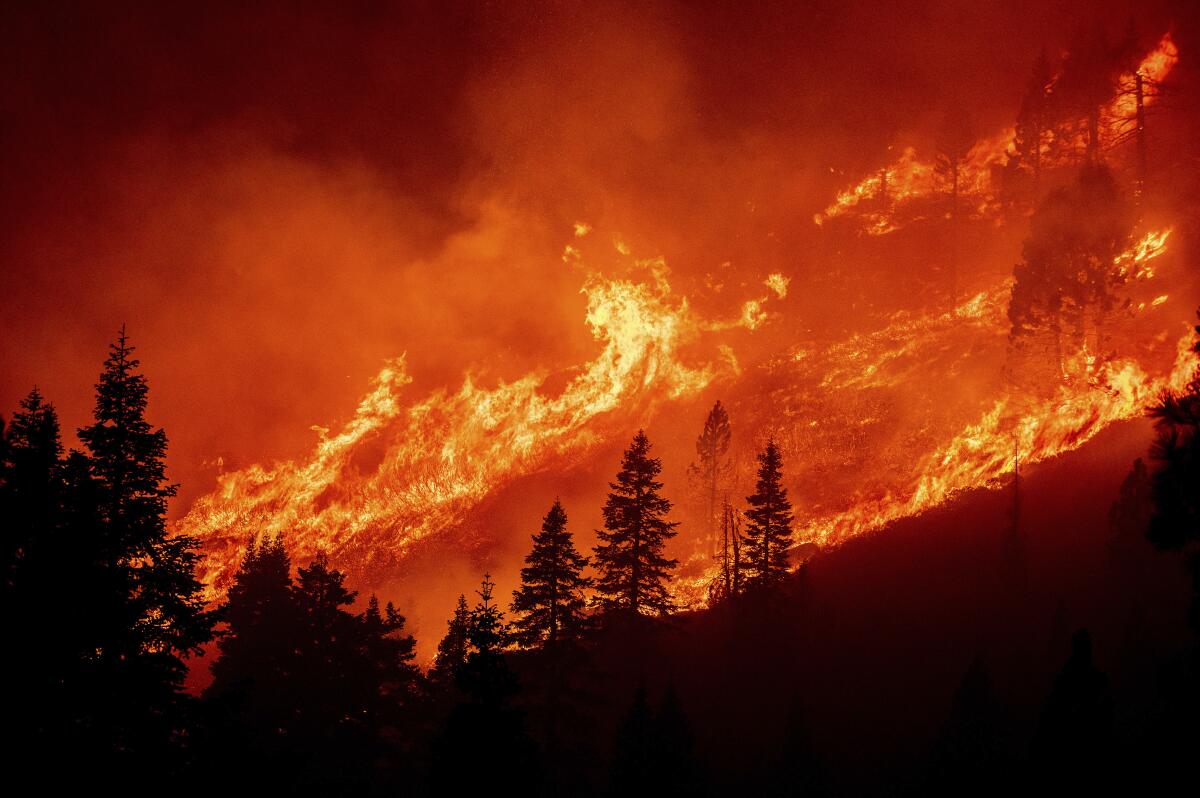
The evacuation order covers nearly all of the Lake Tahoe Basin in El Dorado County, from the California-Nevada state line on the lake’s southern end to Tahoma on its western shore. Just over the state line in Nevada, officials placed many residents under evacuation orders Tuesday afternoon, spurring new concerns that the fire might cross state lines.
At the Douglas County Community Center in Gardnerville, Nev., ash fell from a yellow sky onto dozens of cars and RVs owned by residents who were recently forced to evacuate. Standing near three tents set up at the edge of the evacuation center’s parking lot, Rick and Lee Wright, who are both ski instructors at Heavenly Mountain Resort, said they had never been evacuated from their home before.
“I didn’t think it could happen,” Rick Wright, 60, said. “I thought they would throw an army in there to stop it from getting to Tahoe, but it became real Sunday night, you know?”
Wright said it was around 10:30 p.m. Sunday when a police officer knocked on their door, telling them that there was an evacuation warning but urging them to leave.
“The mandatory evacuation order is coming quickly,” Wright recalled the officer saying. Concerned for his nervous wife and granddaughter, 2-year-old Wynn, he decided to evacuate.
It was about 1:30 a.m. when they began to make the 45-minute drive down the mountain to the evacuation center in Nevada. On the way down he tried to keep his wife calm.
“I just told her we were out,” he said. “ I said, ‘We got the baby, we’re good.’”
At the evacuation center, Wright began to set up the tents, which he had bought five months ago to go camping. “We’re doing it now,” he said, chuckling. “We’re camping.”
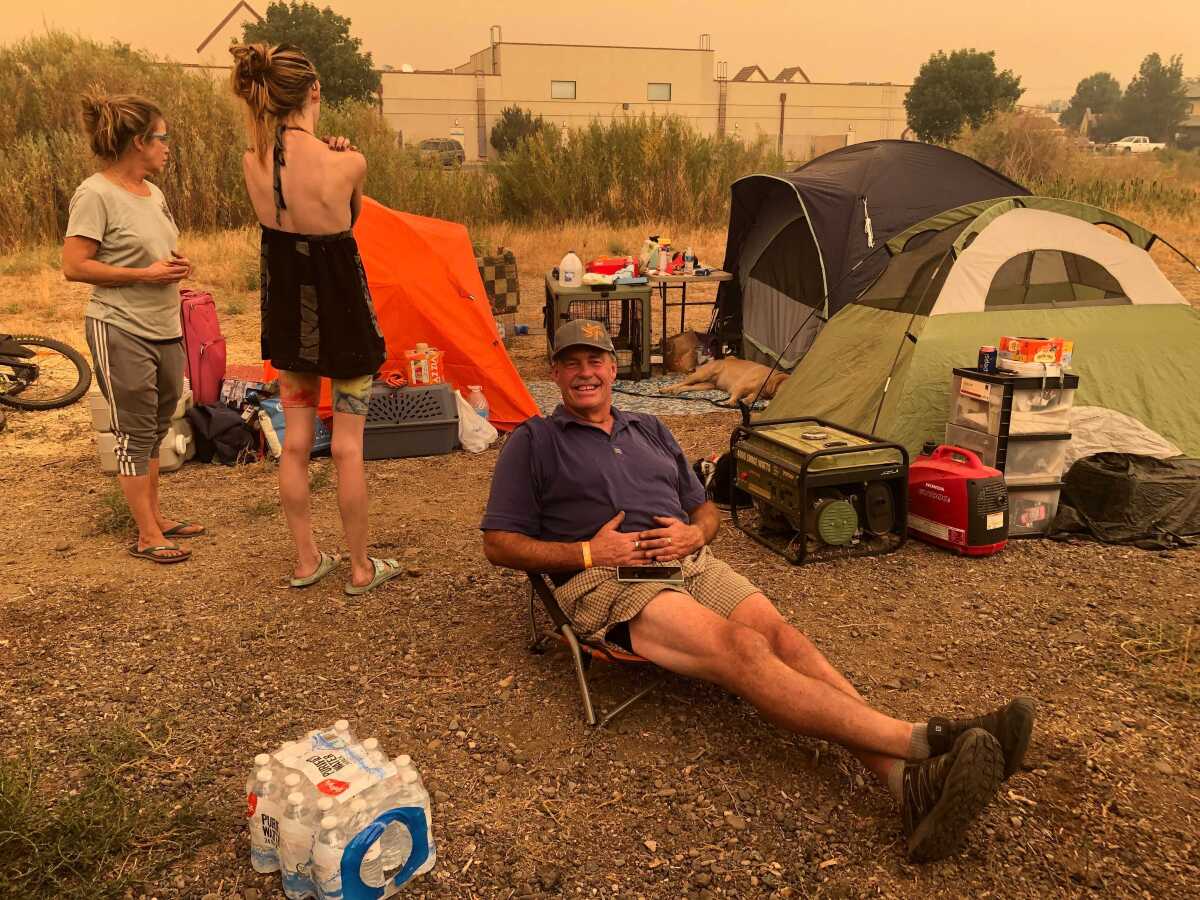
But not everyone heeded the orders.
Jason Pope was one of the few holdouts Tuesday — stuck behind because of an unreliable car and a cat and dog he was housesitting.
“My little car won’t make it down the hill,” he said, gesturing to a 2006 Subaru. He had just reached the friend whose house he was guarding, but who is now overseas on vacation. They offered him the use of their newer Subaru wagon to get the pets to the state line, where Pope’s friend in Cal Fire was going to ferry them to Pope’s uncle.
But Pope didn’t want to cross the evacuation line himself because he wouldn’t be able to return, and he needed to get his own two dogs out.
He said he was not that concerned about the fire, though. He made it through the Angora fire in 2007 and changed out his old shingle roof for one that could withstand flames. He’s got sprinklers going and his neighbors doused their homes and he just doesn’t think the fire will actually make it into town.
Even if it does, he said, his property “is like a mud puddle.”
But the fire’s behavior has been erratic. Operations section chief Tim Ernst said Tuesday that winds over the last 24 hours had blown in excess of 40 mph, with some gusts surging over 50 mph, and were sending embers aloft that could create new fires.
“One of the complexities that we face with this fire is that firebrands can be picked up by winds like that and carried a great distance,” he said. “Yesterday, we had firebrands spotting a mile away from the head of the fire. That’s an extremely challenging fire environment for firefighters to deal with.”
Lake Tahoe faces disastrous ‘urban conflagration’ if Caldor fire reaches communities
Cal Fire officials said they have been preparing for this exact scenario, with one official on Tuesday noting that they may even try to steer the blaze into the footprint of the nearby Tamarack fire, where it could be slowed by the lack of fuel in the freshly burned terrain.
“We knew it could happen, and we spent millions of dollars and thousands of hours on public education, evacuation planning, community meetings, defensible-space inspections, shipping programs, home-hardening outreach, fuels-reduction projects and prescribed fire and forest health projects,” said Anthony, the Cal Fire spokesman.
“Although we cannot predict the outcome of the Caldor fire,” he added, “I want to remind the Tahoe community that you are prepared. … These are no doubt trying times, but we will get through them together.”
Michael Hicks, who owns the historic Strawberry Lodge on Highway 50, was among the many area residents anxiously watching the fire’s path from afar.
“Hopefully they can save as much of the community as possible,” Hicks said. But, he added, that is “up to the winds and the firefighters.”
Times staff writers Rong-Gong Lin and Gregory Yee contributed to this report.
More to Read
Sign up for Essential California
The most important California stories and recommendations in your inbox every morning.
You may occasionally receive promotional content from the Los Angeles Times.
